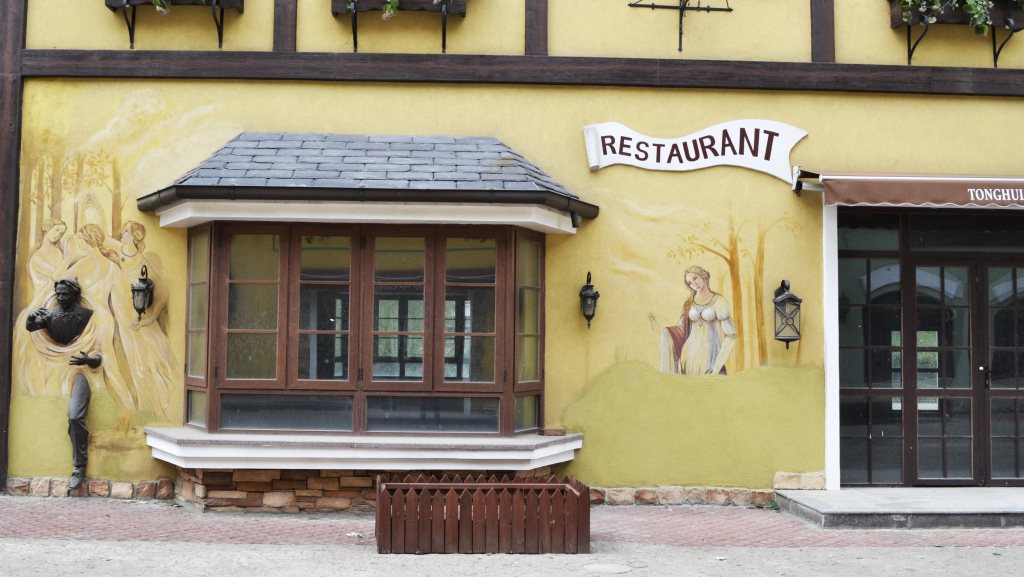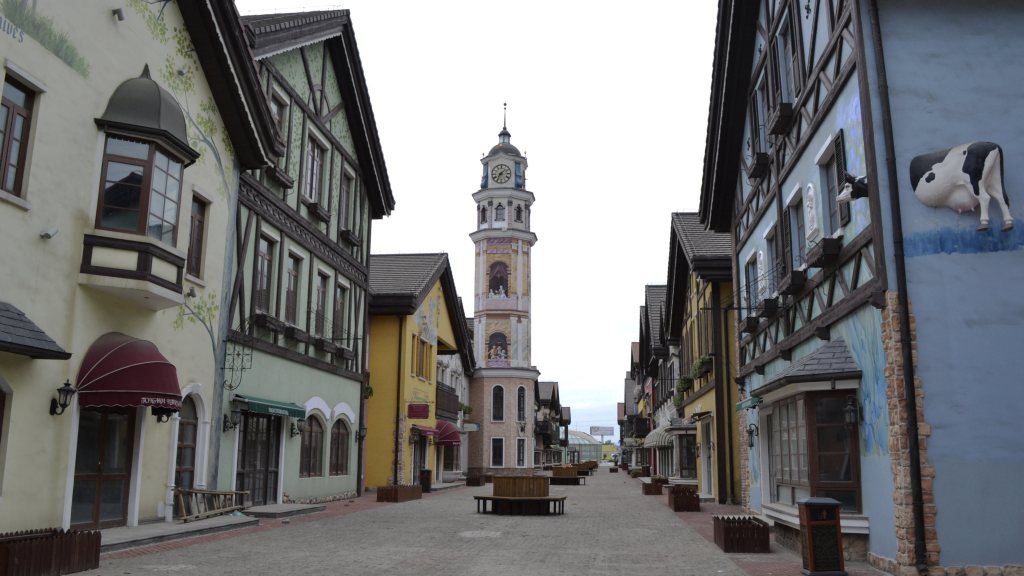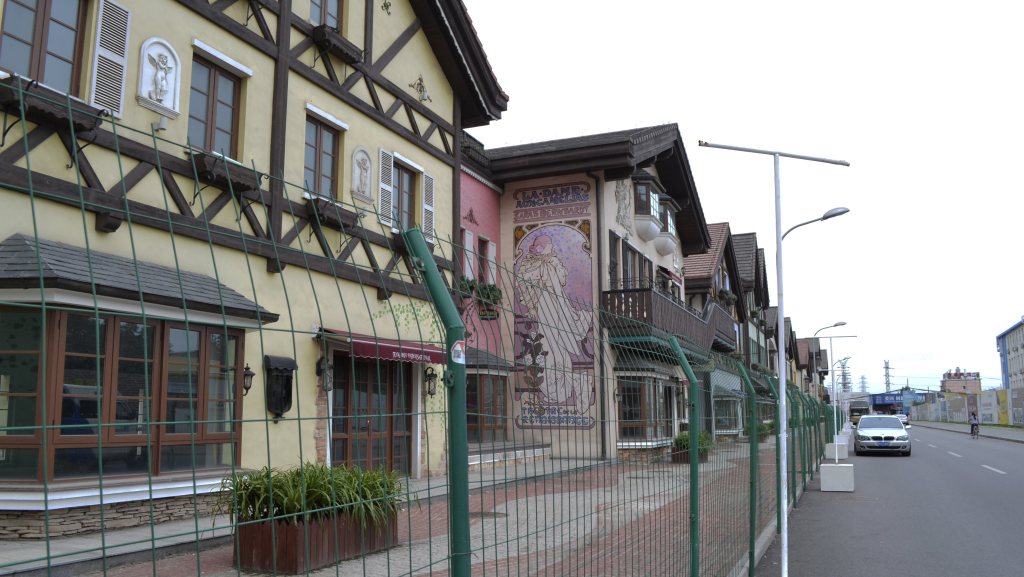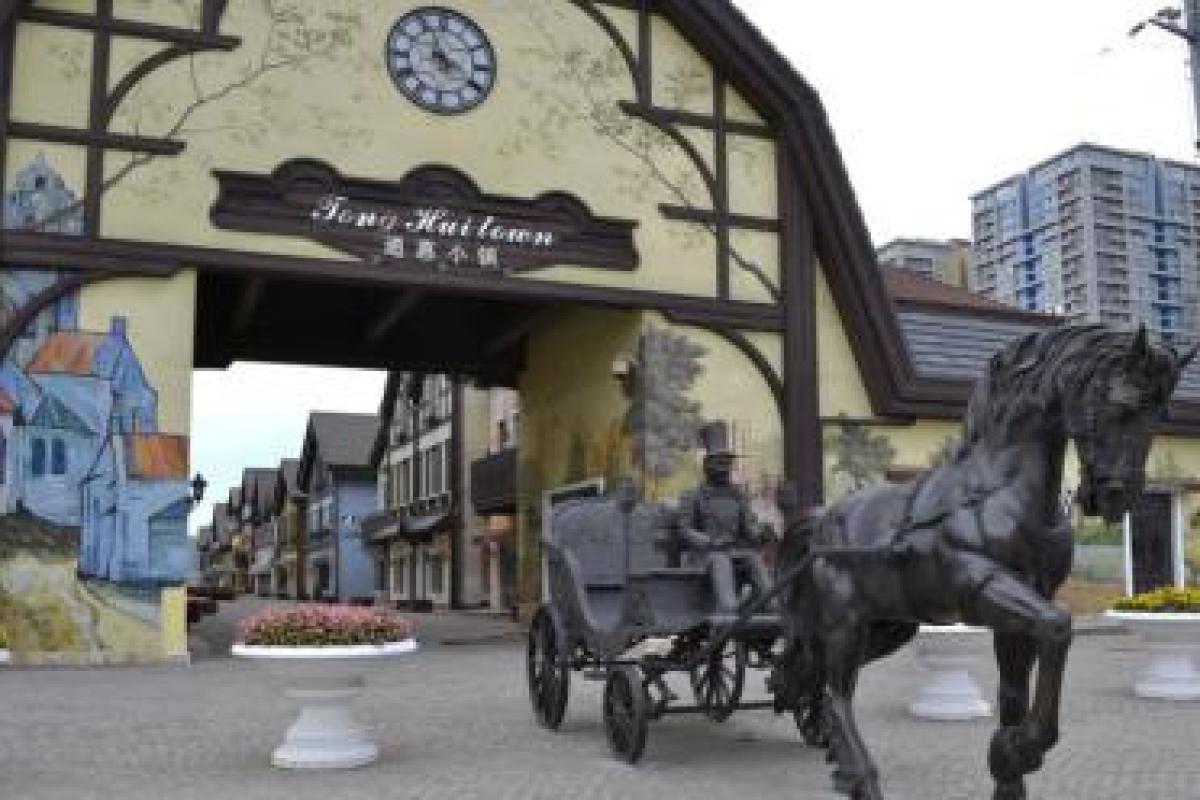Take the Beijing subway one station past the Guomao Zhan (or International Trade Station) stop. From there, walk outside and hail an autorickshaw driver. Tell him you want to go south. Don’t pay more than 10 yuan ($1.63) for the trip, and remember to keep your expectations low: Tonghui Town is still a ghost town.
Located just outside Beijing’s Central Business District (CBD), a re-paint job for this abandoned bar street was supposed to start this September in preparation for the site’s January 2015 opening.
After four years of vacancy, Tonghui’s Virgin Mary, Venus de Milo and Bavarian fraulein murals have faded, but that’s not motivation for property developers to pick up their brushes.
The European-style bar street joins an estimated 1,600 unprofitable theme parks in China, a sign of locals’ discerning taste and failed political ambitions.

Ask site commercial manager Shu Gaofeng why developers are comfortable losing 34,360 yuan ($5,597) per day in rent and he’ll tell you that Tonghui has actually sold all but one of its 32 units. The last four years have just been a failure in branding the area, he said, which would make sense if Tonghui’s parent developing company hadn’t sold office space to Alibaba Group’s, Yahoo China’s and Taobao’s Beijing headquarters on the same plot of land.
Ask site landscape designer Su (who would only provide his surname) why Tonghui is empty and he’ll tell you that after officials traveled from Beijing to Su Landscape headquarters in Shenzhen more than 10 times to perfect the site’s horse, buggy and Bible decor, the release date was pushed because “they’ve been waiting for the government to finish that bridge to connect to CBD so the rent can get a lot higher,” he said.
Yet four bridges already exist between Beijing’s Central Business District and Tonghui Town, and none are under construction.
Both Su and Shu’s explanations rest on the assumption that renters are interested in leasing space that Tonghui offers. But, given the property’s four years of vacancy, the bar street proves that officials from the Chaoyang District Government of Beijing should have conducted a little more market research.

“I wonder whether in Beijing there is a bit of a kind of diminishing interest in this particular style of building,”said Bianca Bosker, author of Original Copies: Architectural Mimicry in Contemporary China.”Beijing just has such a wealth of traditional Chinese architecture and I think there is a sense of great pride in that. I think people really like going to these traditional style houses and back alleys and things like that as opposed to a fake old Europe in the center of Beijing.”
Indeed, the clichéd rise of the “Beijing hutong hipster”—the skinny jean’d, craft beer-drinking ex-pat or Beijinger weaving his fixed-gear bike through the city’s traditional back alleys—proves the hutong lifestyle popular, perhaps because it’s distinctly Beijing. In a city where an estimated one in three people are from somewhere else, maybe it is the taste of this migrant population that Tonghui Town’s developers failed to account for.
“Ten years ago the whole idea that these foreign styles were connected or related to some kind of concept of luxury was popular,” said Beijing architect John Van de Water. “Foreign architects were flown over (to China) to build their national thing. But now I’m not even confronted with these kind of questions anymore.”
Calls for faux Russian palaces, modern Dutch enclaves, and replica White Houses dried at Van de Water’s Beijing-based firm in 2004. Then, the most expensive project in the city was Roma Town, a replica Italian apartment complex located just south of Tonghui.
“Now I don’t know what this project is selling for, but I know that it’s really decreased in price,” Van de Water said.
Roma Town enjoyed a few years of success before depreciating in value. Tonghui never had that opportunity.

Previously, Tonghui Town’s land was used as a wholesale market where migrant farmers travelled to sell their wares. The idea for the bar street was pioneered in 2001, the same year the Summer Olympic Games were announced for Beijing. Construction began in 2007, just a year before the games hit the city. Then, China was engaged in a massive local and international propaganda campaign. Until then, the $42 billion spent in preparation for the Olympics set a record for the greatest amount of money ever put toward an athletic event. Rural migrants were relocated, the site was swept clean and, in just three years, Tonghui was complete.
The breakneck pace at which Tonghui was built reflected bureaucrats’ exuberance. In Beijing, local government officials are judged on development efforts that they are able to complete during their tenure. As such, they often lend financial support to real estate ventures.
In the case of Tonghui Town, the Nanmofang branch of the Chaoyang District Government of Beijing invested 400 million yuan ($65 million) into developing the land. Ironically built “to promote the development of the cultural creative industry in Beijing,” investors saved time in the design phase and reduced architectural fees by copying Swiss, French, and German building facades.
Western-branded communities are often seen as having an established track record in providing a competitive edge in China’s crowded commercial market. Once walls are repainted and the alleged tenants move in, the site commercial manager believes that both foreigners and Chinese alike will flock to Tonghui’s bars.
But John van de Water, co-founder of NEXT architects, said that bar-hopping doesn’t fit the traditional Chinese idea of leisure. After more than 10 years of building in China, he said Beijingers prefer multi-course meals, rounds of baijiu, and singing karaoke at KTV parlors to traipsing around to multiple drinking establishments.
Bosker said that prospective bar patrons could look to the European-themed street as a way to figuratively travel abroad without the expense of actually having to leave the country.
Yet heavy traffic clogs the six-lane highway in front of Tonghui. A string of cheap restaurants line the street where Uighurs, an ethnic Muslim group from China’s far west, heat kabobs with hairdryers. For those interested in reverie, Tonghui’s location is not ideal; it’s situated next to “the fourth-most-expensive location to rent office space in the world.” If someone who lives or works in this area wants to experience Europe, they most likely just get on a plane and go.
This blog came via Fluid's website and originally appeared on Quartz's site. Follow Nona on Twitter @ntepper90.
Read more international content in our Clubhouse.
